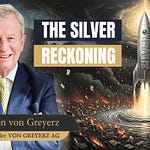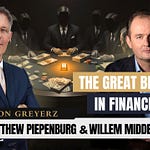As Grant Williams highlights in his report Things That Make You Go Hmmm..., investor Tony Deden calls trust:
“The Invisible Leverage”
not a soft asset, but the silent architecture that makes markets function, societies endure, and promises hold:
Trust cannot be manufactured. It must be earned.
It emerges slowly—through consistency, clarity, and moral courage.
And it vanishes quickly—through duplicity, evasion, or shallow opportunism.When institutions falter and uncertainty rises, it is trust—not trendlines—that preserves continuity.
Trust is not a luxury. It is a form of capital. And in the end, it may be the only one that truly endures.
This series begins there, with trust.
Because before we talk about money, we must talk about meaning.
Gold: Tangible Trust
Gold, at its core, is not a speculative asset. It is trust made tangible.
It does not promise yield, but it does not break promises either.
It is no one else’s liability, and it cannot be printed, defaulted on, or debased.
In a world staggering under the weight of unsustainable debt, manipulated currencies, and failing institutions, gold represents permanence—something solid when nearly everything else feels uncertain.
Egon von Greyerz has spent decades studying the arc of financial history. His message is clear: gold is not about timing the market. It is about building resilience before the crisis hits.
First Principles of Preservation
These episodes distill Egon’s philosophy into three enduring principles:
Real money is tangible.
Paper promises fail.
Wealth must be protected before it can be enjoyed.
This is not a series about chasing returns.
It’s about preserving the only capital that truly matters—trust.
Whether you’re new to gold or re-evaluating your strategy, this is a clear, sober path toward financial resilience. One built not on forecasts, but on foundations. Not on speculation, but on structure. Not on hype, but on history.
Episodes
Episode 1: Gold as Financial Insurance, Not Just Investment
Gold is not for speculation — it is wealth preservation and freedom.
Hold it in physical form, outside the banking system, in safe jurisdictions.
Protects against inevitable collapse of currencies and financial structures.
Episode 2: The Decline of Fiat Currencies
Since 1971, all major currencies have lost 99% of their value against gold.
Every fiat currency in history has eventually gone to zero.
Paper money and debased silver are “fake money” compared to physical gold.
Episode 3: Safe Storage and Jurisdiction Choices
Keep gold where only you can access it — not in the system you’re hedging against.
Jurisdictions under stress may impose capital controls or seize assets.
Safer alternatives include Switzerland or Singapore.
Episode 4: Gold as Stable Purchasing Power
Gold’s value doesn’t rise — it stays stable while currencies fall.
Example: one ounce of gold bought a fine suit 2,000 years ago and still does today.
Gold is “nature’s money” and maintains purchasing power over generations.
Episode 5: Beyond Money, Life and Wealth Preservation
Owning gold is financial insurance, but life should not revolve around money.
Secure your wealth, then focus on family, friends, nature, and culture.
In difficult times, helping others is more important than financial gain.
Episode 6: Why Bitcoin Isn’t a Replacement for Gold
Bitcoin is digital, speculative, and has no intrinsic value.
It could rise dramatically, but could also collapse to zero.
Gold (and some silver) held physically is the only true wealth-preservation asset.
Episode 7: Physical Gold Over Paper or Tokenized Forms
ETFs, paper gold, or tokenized gold won’t hold value in a systemic crisis.
Only physical gold and silver under your control provide real protection.
Keep assets outside the financial system to avoid loss in a collapse.
Episode 8: How Much Gold to Hold
For 25 years, the recommendation has been 20–50% of assets in gold.
Some investors hold nearly 100% in gold and have done well long term.
Today, at least 20–25% is considered the minimum for protection.
Episode 9: Silver’s Unique Wealth Preservation Opportunity
Silver is undervalued compared to gold, with potential to move 2–3x faster.
Historically reached $50 but could exceed it significantly in the next cycle.
Suggested allocation: 20–30% in silver for wealth preservation, despite volatility.












